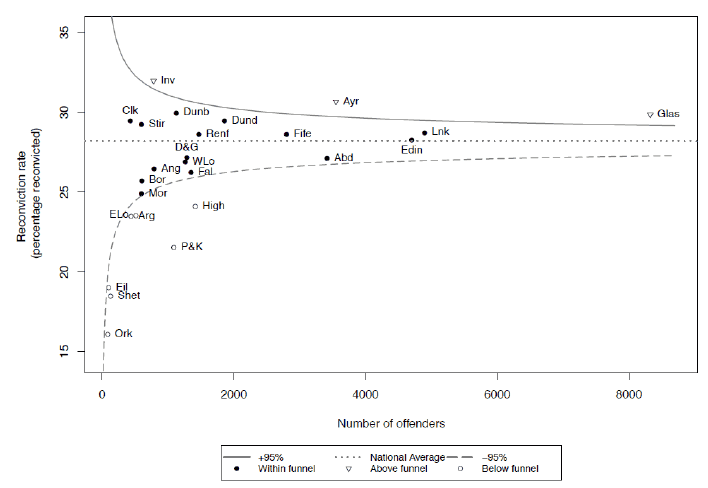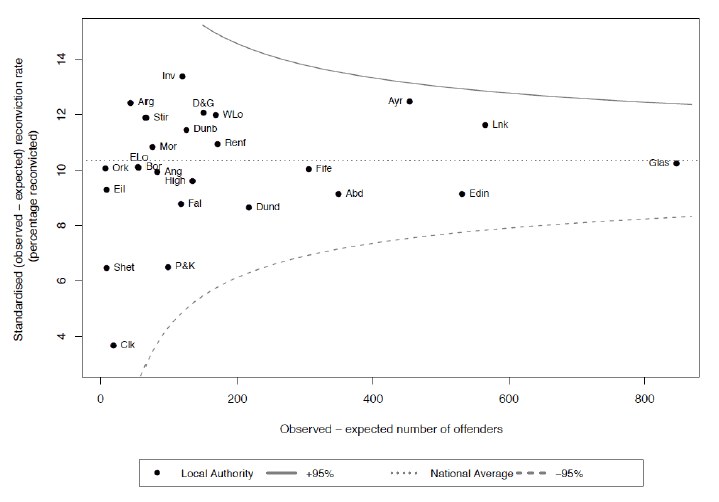Reconviction rates in Scotland: 2014-2015 offender cohort
Analysis of trends in reconviction statistics up to the latest cohort of 2014 to 2015.
This document is part of a collection
3. Comparing reconviction rates across administrative areas
( Table 11)
The reconviction rate for an administrative area is based on information for offenders convicted in courts that fall within that administrative area's boundary. Typically an offender would go to a court located in the same administrative area in which they live, though occasionally an offender may be seen by a court located in a different administrative area. Similarly an offender may not always be supervised in the area in which they are convicted and subsequent reconvictions may have occurred in different areas. In addition, the areas that courts serve don't exactly match Local Authorities (see Annex A10 and the footnote of Table 11).
Reconviction rates vary across administrative areas (based on court location). Table 11 shows that the highest reconviction rate in the 2014-15 cohort was for offenders whose index conviction was given at courts in Inverclyde (32.0%), which also has the highest number of reconvictions per offender (0.55). The lowest reconviction rate (16.1%), and lowest average number of reconvictions per offender (0.20), were both for offenders whose index conviction was given at a court in the Orkney Islands. These are unadjusted figures which do not take account of underlying differences in population size and the characteristics of offenders in each area. It should also be noted that several Local Authorities have small numbers of offenders, within which small between year fluctuations in the numbers of offenders reconvicted may lead to larger changes in the reconviction rate and average number of reconvictions per offender than for Local Authorities with larger numbers of offenders.
3.1 Accounting for the variability between local authorities
Reconviction rates are used as a Scottish Government National Indicator in the Scottish Government's National Performance Framework. As such, they are commonly used to rank performance across different jurisdictions and Local Authorities. However, there is an inherent problem in using this approach since it implicitly assumes that a difference in reconviction rate reflects a 'real' difference between organisations. In reality, all systems within which these organisations operate, no matter how stable, will produce variable outcomes in the normal run of events. In particular, outcomes in jurisdictions with smaller sized populations tend to vary more than those in jurisdictions with larger populations. The question we need to answer is therefore: Is the observed variation more or less than we would normally expect?
In this respect, it is better to use a method of comparison that takes account of inherent variability between jurisdictions [2] . The funnel plot is a simple statistical method that takes into account the variability of different sized populations and so highlights whether there are differences that may be attributed to some other special cause [3] .
Table 11 shows the average number of reconvictions per offender and reconviction rates for each Local Authority group and Chart 10 shows the reconviction rates against the number of offenders. The plot takes into account the increased variability of the Local Authorities with smaller populations, where a small increase in the number of reconvictions may lead to a large percentage change in the reconviction rate. Rates for Local Authorities which lie inside the funnel are not significantly different from the national rate, and we can then usefully focus on possible explanations for rates which deviate significantly from the national figure. In this case, the cut-off level for statistical significance is 95% (or two standard deviations from the mean): if there were no difference between Local Authorities apart from that which could reasonably be attributed to random variation, we would expect that 5% of the authorities ( i.e. only 1 of them) would lie outside the funnel.
Chart 10: Reconviction rates by Local Authority group: 2014-15 cohort 4

Chart 10 shows that Inverclyde, East North and South Ayrshire and Glasgow City lie above the funnel, and so have higher reconviction rates than expected. East Lothian, Argyll and Bute, Highland, Perth and Kinross, Na h-Eileanan Siar, the Shetland Islands and the Orkney Islands lie below the funnel and so have lower rates than expected. Whilst this is useful for highlighting that there are practical differences in reconviction rates between each Local Authority, even after taking into account differences in population sizes, it does not allow us to identify if this disparity is due to variation in the characteristics of offenders in each area or a variation in practices between different Local Authorities. Different offender characteristics between Local Authorities could include: age, gender, crime, disposal, ethnicity, deprivation, etc.
Chart 11 is standardised to take into account differences between Local Authorities attributable to the characteristics of offenders, such as the number of previous offences, sentence, gender, and age. It provides the standardised reconviction rates [4] against the observed number of offenders minus expected number of offenders. Since all Local Authorities are within the funnel it suggests that the apparent differences in reconviction rates in Chart 10 are primarily attributable to either the variation in the characteristics of the offenders, the type of crime they committed, or the sentence they received, rather than differences in 'performance' between the Local Authorities. This overall conclusion for all local authorities on the 2014-15 cohort is consistent with the findings of the previous two cohorts provided in the 2012-13 and 2013-14 Reconviction Rates in Scotland publications.
Chart 11: Standardised reconviction rates by Local Authority group: 2014-15 cohort 8

Contact
Email: Mariken Schipper
Phone: 0300 244 4000 – Central Enquiry Unit
The Scottish Government
St Andrew's House
Regent Road
Edinburgh
EH1 3DG
There is a problem
Thanks for your feedback